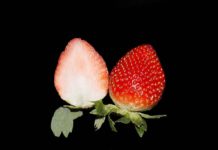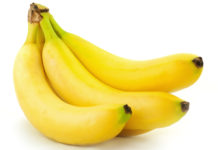Plantain is a fruit that looks like a banana. Scientifically it is known as Musa paradisiaca, which are a type of fruit that is widely cultivated in many tropical regions around the world, including Africa, South America, and the Caribbean. They are a close relative of the common banana and are often referred to as cooking bananas because of their starchy, low-sugar flesh. Unlike their sweet and juicy counterpart, plantains are typically used in savory dishes and are cooked before being consumed.
The plantain banana that isn’t a banana is larger and thicker skinned than the banana and has a more elongated shape. The skin of the plantain is usually green when unripe and turns yellow or black as it ripens. Unlike the sweet aroma of ripe bananas, unripe plantains have a starchy smell and taste. They are versatile ingredients in cooking and can be fried, boiled, baked, or grilled.
In Africa, plantains are a staple food that is often cooked and mashed, then mixed with spices and served as a side dish with stews and curries. In South America, they are sliced and fried to make a popular snack called “tostones”. Plantains can also be used as a substitute for potatoes in dishes such as “platano relleno”, which is a stuffed plantain dish, or in soups and stews.
Plantains are an important source of nutrition for many people in tropical regions and are rich in vitamins, minerals, and dietary fiber. They are a good source of potassium, which is important for maintaining proper heart function and fluid balance, and also contain vitamin C, vitamin A, and iron.
One unique feature of plantains is that they are low in sugar compared to regular bananas. This means that they are a good option for people who are looking to manage their blood sugar levels or limit their sugar intake. Additionally, they are a good source of resistant starch, which acts like soluble fiber and can help regulate the digestive system.
The plantain plant grows from a pseudostem, which is made up of tightly packed leaves that grow from the base of the plant. Plantains are propagated through a process called “suckering”, where new plants sprout from the base of the mature plant. They are a hardy crop and can withstand harsh environmental conditions, making them a valuable food source for many communities in developing countries.
Therefore, plantains are a type of fruit that closely resemble bananas, but are larger and have thicker skin. They are a staple food in many tropical regions and are used in cooking as a starchy vegetable rather than eaten raw. Plantains are a good source of nutrition and are low in sugar, making them a good option for people looking to manage their blood sugar levels. They are also a valuable food source for many communities in developing countries due to their hardiness and versatility in cooking.

Plantain vs Banana
Plantains and bananas are two different types of fruit, but they are closely related and often confused with each other. The main differences between the two include:
-
Shape and Size: Plantains are generally larger and have a more elongated shape than bananas. They are also thicker-skinned and have a more rugged texture.
-
Ripeness and Sweetness: Bananas are sweeter and softer than plantains and are usually eaten raw when they are ripe. Plantains, on the other hand, are starchy and are typically cooked before they are eaten. They are considered ripe when the skin turns yellow or black, but they will still be quite firm.
-
Culinary Uses: Plantains are used as a starchy vegetable in cooking, whereas bananas are often eaten as a sweet snack. Plantains are often fried, boiled, baked, or grilled and are used in savory dishes, whereas bananas are typically used in sweet dishes, such as smoothies, baking, and fruit salads.
-
Nutritional Content: Plantains are lower in sugar and higher in fiber and starch than bananas. They are also a good source of vitamins, minerals, and antioxidants, including potassium, vitamin C, vitamin A, and iron.
Thus, plantains and bananas are similar in many ways, they have distinct differences in shape, ripeness, culinary uses, and nutritional content, making them unique fruits in their own right.
Types of Plantains and Recipes
There are several types of plantains, each with slightly different characteristics and uses in cooking:
Green Plantains: These are unripe plantains and have a firmer texture and starchy flavor. They are typically sliced and fried to make tostones or used in savory dishes, such as plantain chips or mashed plantains.
Yellow Plantains: These are partially ripe plantains and have a sweeter flavor and softer texture than green plantains. They are often baked or grilled and used in sweet dishes, such as plantain cakes or sweet plantain pie.
Black Plantains: These are fully ripe plantains and have a very sweet flavor and soft texture. They are often mashed and used in sweet dishes, such as plantain pudding or sweet plantain bread.
Here are a few plantain-based recipes to try:
Tostones: Sliced green plantains are fried until crispy and then served as a snack or side dish.
Mofongo: A Puerto Rican dish made with mashed plantains and fried pork cracklings, served with a savory broth or sauce.
Plantain Chips: Thinly sliced green plantains are fried until crispy and served as a snack or appetizer.
Sweet Plantain Pie: A sweet dessert made with ripe plantains, sugar, cinnamon, and butter.
Plantain Pudding: A sweet dessert made with ripe plantains, sugar, milk, and spices.
These are just a few of the many delicious and versatile plantain-based recipes. Whether you prefer them sweet or savory, plantains are a tasty and nutritious ingredient that can be used in a variety of dishes.







